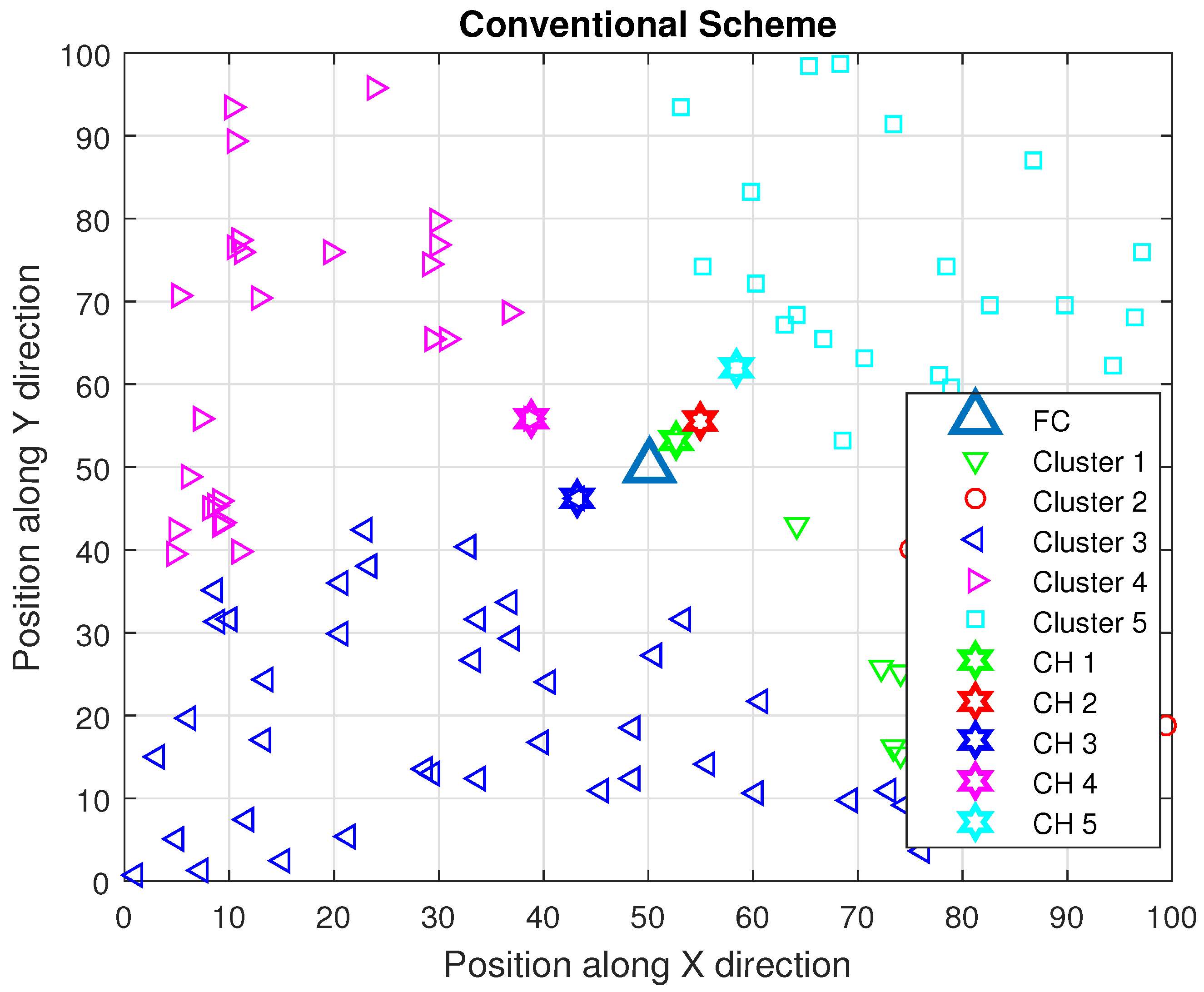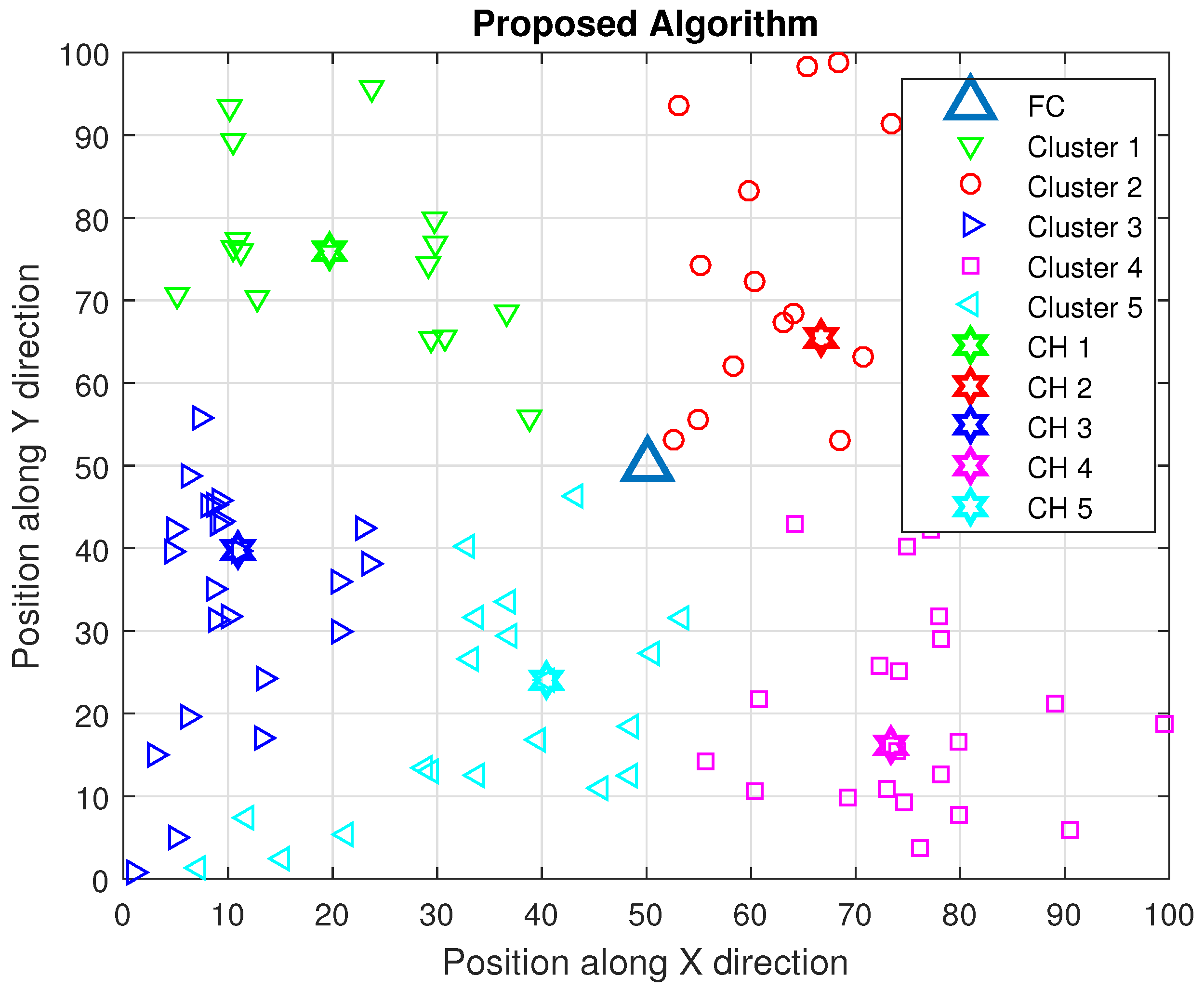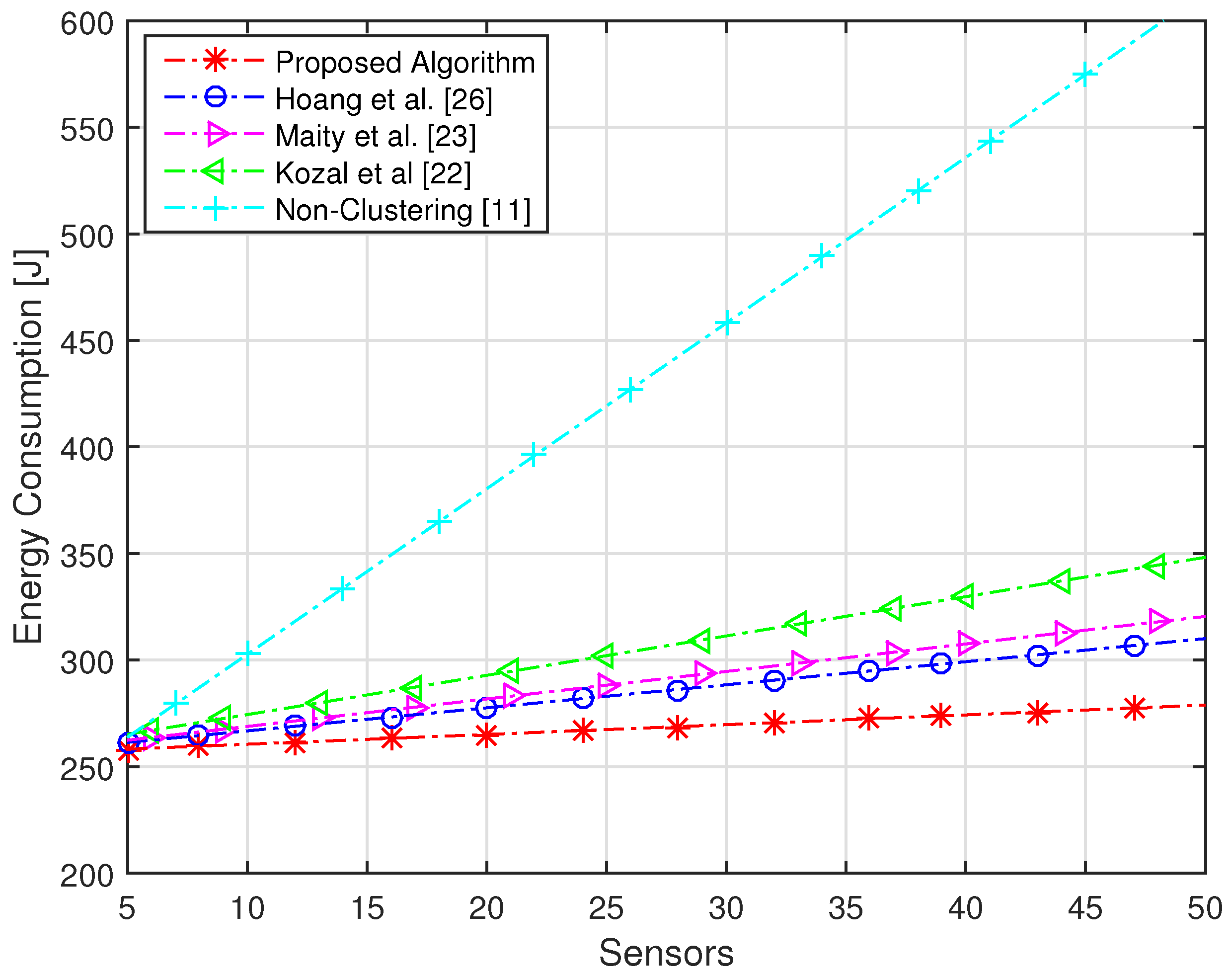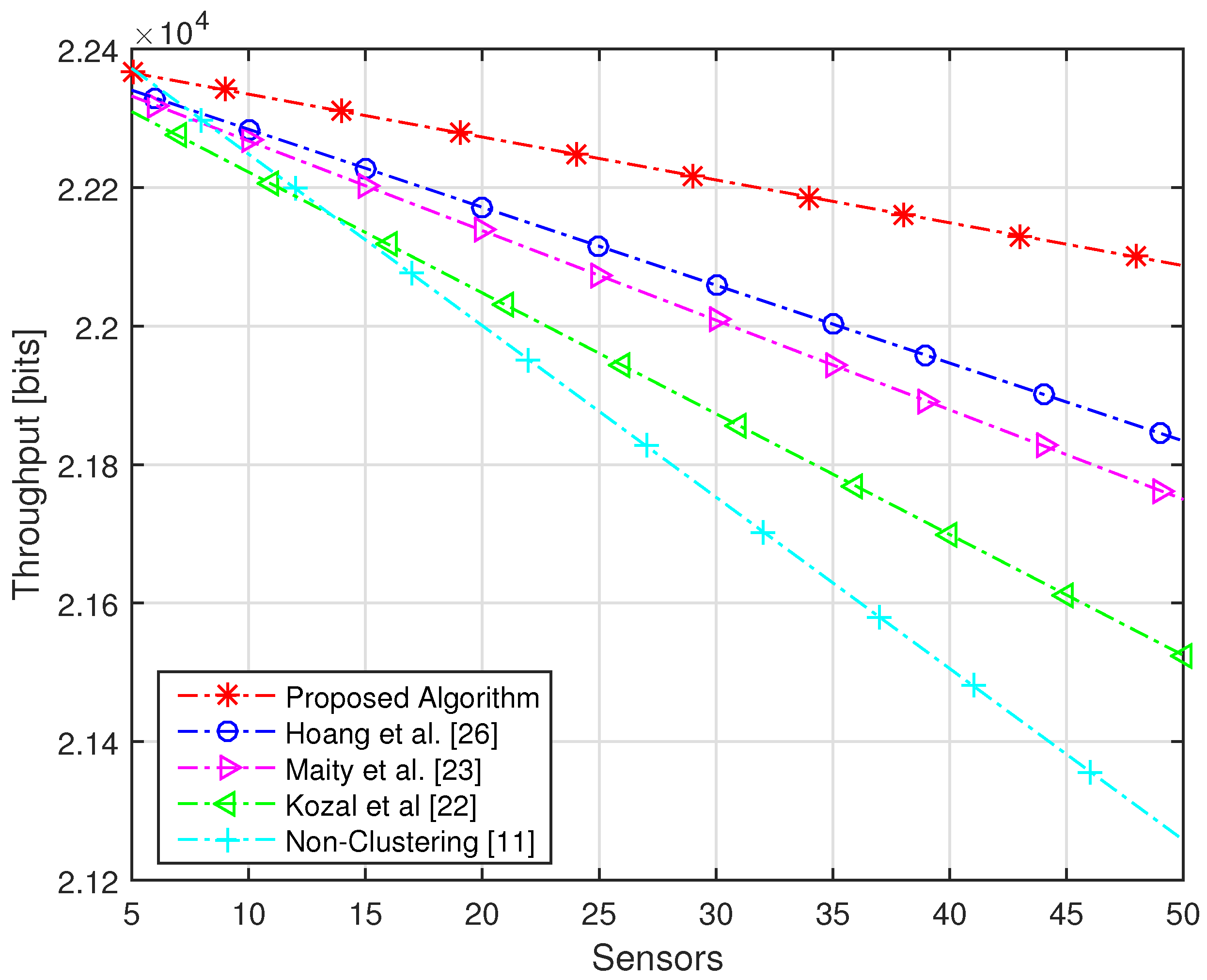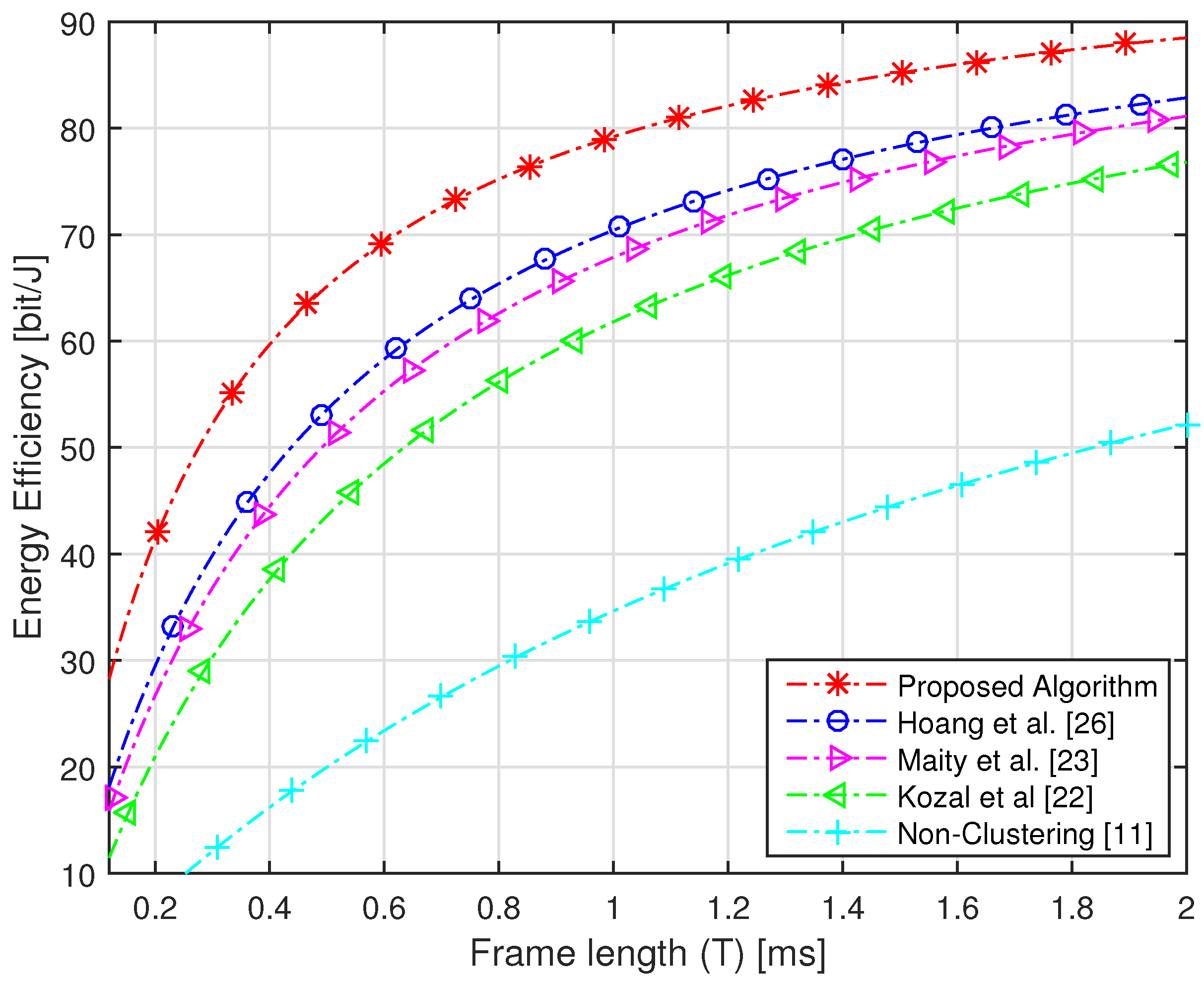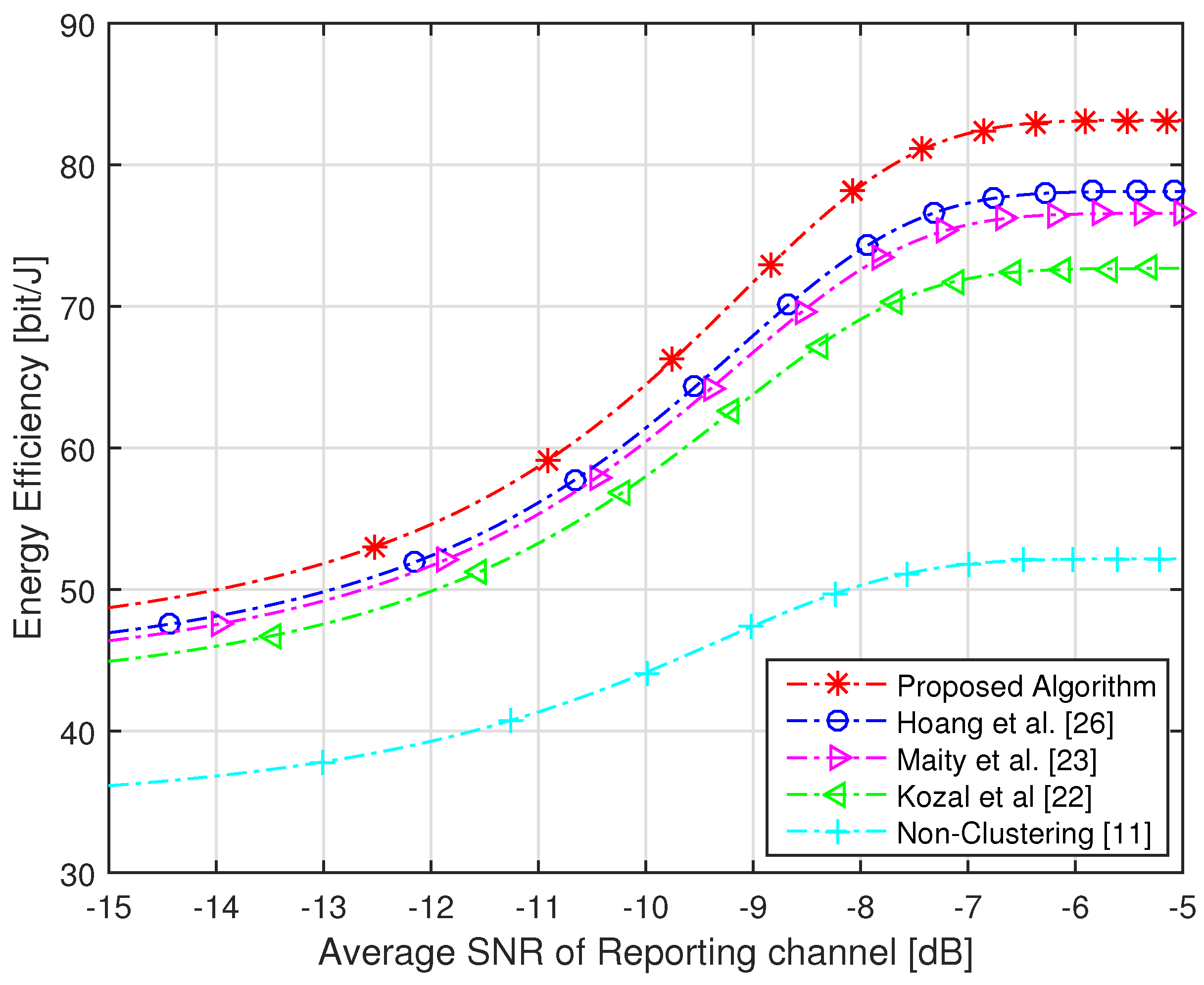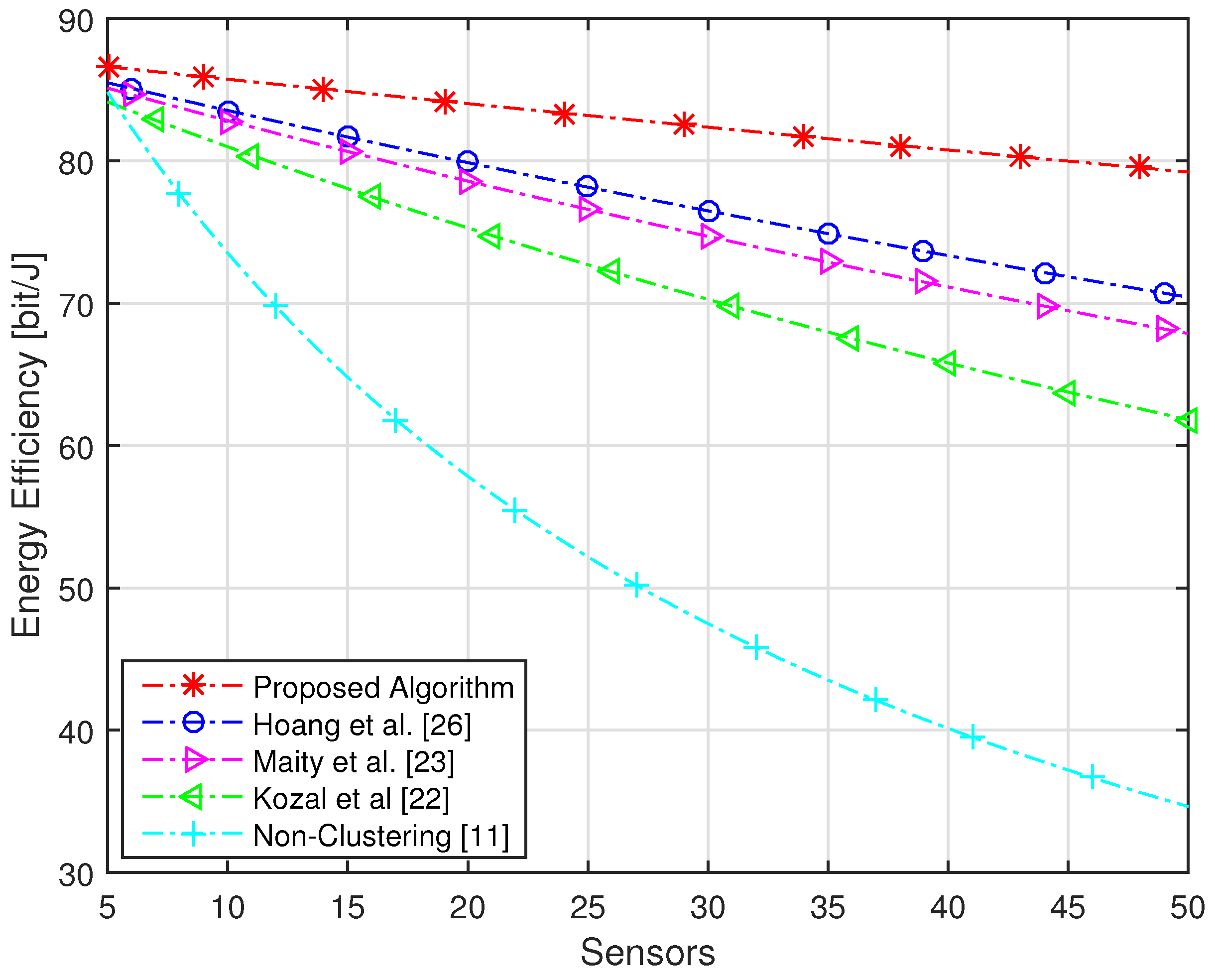1. Introduction
Due to explosive demand for wireless communication during the last decade, broader spectrum resources are needed. However, spectrum resources are limited and are allocated according to a fixed spectrum assignment policy. The concept of sensing the spectrum was first presented by Mitola [
1] to solve the problem of spectrum scarcity pointed by the Federal Communication Commission report [
2]. The goal is to sense frequency band and utilize that band, if the licensed user called a primary user (PU) is not using it. Thus, the detection performance in the spectrum sensing is crucial to the performance of both PUs and the sensor network. The detection performance can be primarily determined on the basis of two metrics: probability of false alarm, which denotes the probability of a sensor declaring that a PU is present when the spectrum is actually free, and the probability of detection, which denotes the probability of a sensor declaring that a PU is present, given that the spectrum is indeed occupied by the PU. Since the detection avoids the interference with the PU and a false alarm reduces the spectral efficiency, it is usually required for optimal detection performance that the probability of detection is maximized subject to the constraint of the probability of false alarm.
There are several spectrum sensing techniques available in literature, some of which are matched filter detection [
3], energy detection [
4], cyclostationary detection [
5], wavelet detection [
6], and covariance detection [
7]. Among them, energy detection is widely applied for sensing the spectrum as it does not require any prior knowledge of primary signals and has much lower complexity than the others [
8,
9,
10,
11,
12,
13]. Therefore, this paper also considers energy based detection.
The sensing decision of a single sensor may not be reliable enough due to shadowing, multipath fading and the time varying nature of wireless channels between sensors and PUs. To overcome these effects, the literature is brimming with cooperative spectrum sensing schemes to take advantage of spatial diversity [
14,
15,
16,
17]. In cooperative spectrum sensing, sensors of whole network share sensing information to the Fusion center (FC) which is combined to make the final decision. This can result in an excessive consumption of the network energy when large number of sensors are cooperating, therefore sensors are sometimes divided into clusters, which is called a cluster based cooperative spectrum sensing.
Each sensor delivers sensing information to the FC in one of the two ways: hard information, and soft information. In [
15,
16], hard information is considered, where each sensor sends only one bit of information regarding the detection of PUs. In soft information, accurate average energy values observed by all sensors are reported to FC, which are combined to make a final decision. It is shown in [
18] that soft information combining outperforms hard combining. Hence, a soft combination is considered in this paper. Note that each sensor performs the spectrum sensing via sensing channel and forwards the sensing information to the FC via reporting channel.
Since each sensor consumes energy in sensing PU signals and reports that sensed energy to FC; consequently, cooperative spectrum sensing can cause high overall energy consumption in the whole network when a large number of sensors are involved in cooperation. To combat this problem, grouping the cooperative sensors into clusters [
19,
20,
21] for cooperative sensing is an effective method to reduce the energy consumption.
The clustering techniques with respect to sensing efficiency have widely been shown in literature [
19,
20], but very few energy efficient schemes have been proposed [
22,
23,
24,
25,
26], although the energy efficiency is one of the most important factors for the designing of sensor networks. To the best of the author’s knowledge, clustering schemes have mostly used perfect channels and have considered hard decisions. Thus, using imperfect channels, we have proposed a novel cluster based soft combining scheme for energy efficient spectrum sensing in sensor networks, in which maximum sensing efficiency is achieved with less consumption of energy. In [
19], the authors have proposed a clustering method for spectrum sensing, in which sensors with largest reporting channel gain are selected as cluster heads (CHs) to reduce the reporting error. In [
20], four clustering methods are shown to reduce the overhead depending on the location information of sensors. In [
21], a cluster-based cooperative spectrum sensing scheme is proposed to address the control channel and sensing delay problems. However, these cluster-based spectrum sensing approaches do not focus on the energy consumption. In [
22], authors have focused on energy consumption in cooperative spectrum sensing and have proposed a multi-hop cluster based cooperative spectrum sensing for reducing wastage of energy, in which CHs are selected based on distance between FC and sensors, reporting channel gain and energy level. However, based on these parameters, FC most likely select the nearest sensors to it. In [
23], authors have proposed the method that uses the fuzzy c-means (FCM) technique for the cluster formation. However, there are few drawbacks, i.e., (i) each sensor forwards its sensing measurement to FC even though authors have divided the network into clusters; (ii) only making clusters does not always lead us to save energy, CH selection after making clusters plays a big role in the saving of energy; (iii) after cluster formation, each sensor forwards its sensing information to the FC for cluster decision, due to which a large amount of energy is consumed, and (iv) authors have considered the perfect channel that does not give assurance of the sensing efficiency. In [
26], authors have also used FCM for the cluster formation and have selected the CH based on residual energy of the sensor. However, there are few flaws, such as: (i) authors have not shown energy efficiency of the network; (ii) the selection of CH based on only single parameter does not give certainty of energy efficiency; and (iii) the CH selection based on individual residual energy does not lead us to save energy, it only selects the CH based on amount of energy left in the sensor.
The above clustering schemes have not considered imperfect channels and have either focused on sensing efficiency or energy efficiency. By considering imperfect channels, we have proposed an algorithm that achieves maximum sensing efficiency and obtains the highest energy efficiency.
The main goal of this paper is to get the maximum probability of detection under an imperfect reporting channel, minimize the energy consumption by efficiently making the clusters and select CHs to improve the energy efficiency for the sensor networks. More specifically, a clustering based sensing scheme is proposed, in which clusters are made using the FCM technique to save energy consumption, and, furthermore, to save energy, CHs are selected based on four parameters: the location of sensors within cluster, location with respect to FC, sensor’s residual energy, and signal-to-noise ratio (SNR) of the reporting channel of the sensors. The main contributions of this paper are: firstly, the overall energy consumption of the whole networks is reduced using the proposed algorithm; secondly, maximum probability of detection is achieved under an imperfect reporting channel with smaller consumption of energy; and, finally, maximum efficiency of the network is achieved.
The rest of this paper is organized as follows.
Section 2 describes the problem statement.
Section 3 describes the system model. The proposed scheme is shown in
Section 4. Simulation results are shown in
Section 5. Finally, conclusions are summarized in
Section 6.
2. Problem Statement
The detection performance of the network is determined on the basis of probability of false alarm () and probability of detection (). The false alarm reduces the spectral efficiency of a sensor network and maximum probability of detection avoids the interference with PU. There are three phases in cooperative spectrum sensing; the first one is the sensing phase, in which all cooperative sensors perform local spectrum sensing; the second one is the reporting phase, in which local sensing data is reported to the FC in order to make the final decision by combining sensing measurement of all sensors, and the last one is the data transmission phase, in which data of sensors is transmitted if the PU is not active. Each sensor consumes energy on sensing the PU and reporting the sensed information to the FC due to the distance between them. Thus, as the number of sensors in the cooperative sensor network is increased, more energy is consumed.
To overcome the problem of energy consumption, many clustering methods are proposed, in which the whole network is divided into a small number of groups called clusters. Dividing the network into a small number of clusters saves energy, as FC has to receive the sensing information from CHs only, which is combined information of all cluster members. Every sensor forwards the sensing data to its CH and each CH combines the sensing information of its cluster member, which is forwarded to FC for the final decision. An energy efficient clustering method is dependent of two entities, one is the cluster formation and the other is the CH selection. Many of the authors have proposed cluster formation and CH selection methods, in which CHs are selected randomly or based on received signal strength indicator (RSSI) at FC from CHs, and, furthermore, CHs select their cluster members randomly or based on RSSI at CHs from sensors [
24,
25]. In [
24], authors have proposed CH selection based on RSSI, energy level, reporting channel gain and distance between FC and CHs. In [
22], authors have proposed a modified version of a well-known cluster making method low energy adaptive clustering hierarchy (LEACH), in which CHs are selected based on energy levels. However, all of these cluster formation methods have uneven distribution of clusters and most likely the nearest sensors to the FC are selected as CHs, which results in large distances between the CHs and their cluster members as shown in
Figure 1 since all sensors forward their sensing measurement to their CHs . Hence, the large distance between the CHs and their cluster members causes huge energy consumption. In our proposed algorithm, the intention is to select the CH near its cluster members, but we also do not want it to be very far from FC. Thus, we have used FCM for the making of clusters and considered both distances, i.e., distance between CHs and their cluster members and distance between CHs and FC, for the selection of CH. The FCM is the technique that assigns degree of membership to a cluster for each sensor, which leads us to overcome the issue of uneven distribution. The FCM has been proved to enhance the network performance in terms of energy consumption [
26].
The goal is to get the maximum probability of detection under an imperfect reporting channel with minimum energy consumption of the network by making energy efficient clusters and by selecting the best CH among each cluster. Our proposed algorithm makes the clusters using FCM and selects CHs based on sensor’s location, distance, residual energy and SNR. To be more specific, the idea is to divide the whole network into some number of clusters using FCM, and select the CHs based on the four parameters, location of sensors within cluster, location of sensors with respect to FC, SNR of the sensor’s reporting channel and sensor’s residual energy. Our proposed algorithm achieves its highest efficiency as the use of FCM reduces the energy consumption of the network, and selection of CHs based on our algorithm not only saves more energy but also achieves the highest performance of the network.
3. System Model
Consider a network of
N cooperative sensors with one FC, which is divided into
M number of clusters each with one CH and a PU. The sensors are randomly distributed as shown in
Figure 2.
The topological structure of the sensor network is represented by a network graph
G, with each vertex representing the position of sensor in two-dimensional space, i.e.,
for the
ith sensor. We put an edge for the link between the
ith and
jth sensor if they are located within a certain communication range
r; otherwise, there is no edge if they are out of communication. An edge is also defined for the link from a PU to each sensor if the PU is detected by the sensor through spectrum sensing. The objective of the sensor is to sense the spectrum and opportunistically utilize it if not used by a PU. Each cluster consists of a CH, which combines the sensing measurements from all sensors of that cluster and forwards that combined sensing measurement to the FC. Thus, the process of cooperative sensing starts with spectrum sensing performed individually at each sensor called local spectrum sensing. The time frame of cooperative spectrum sensing is divided into four sub frames, the sensing time
of sensors, reporting time
of cluster members to their CHs, reporting time
of CHs to the FC and data transmission time
. Therefore, the total frame duration can be written as
where
is the number of sensors in the
mth cluster, which is the largest cluster of the network in terms of sensors and
M is the total number of clusters in the network. The performance of cooperative spectrum sensing can be analyzed by
,
, throughput, energy consumption and energy efficiency. The goal is to get the maximum detection performance under imperfect reporting channels with minimum energy consumption of the network while not allowing the probability of a false alarm to exceed a certain value. In other words,
should be kept below a maximum tolerable probability of false alarm
, which is defined in next section.
5. Simulation Results
The target of the proposed algorithm is to acquire the highest sensing performance under an imperfect reporting channel with maximum energy efficiency. The sensing performance is dependent on
and
, while energy efficiency is defined by energy consumption and throughput. The performance of the proposed algorithm is verified by comparing the performance with non-clustering and conventional clustering schemes. The network consists of a maximum of 100 numbers of sensors, which are divided into five numbers of clusters with each cluster having random numbers of sensors assigned based on FCM. We have compared our algorithm with [
11,
22,
23,
26]. In [
11], sensors of the whole network forward their sensing information to the FC, due to which the highest amount of energy is consumed. In [
22], a modified version of cluster making method LEACH is proposed, in which sensors share their information with neighbor nodes. In [
23], the network is divided into clusters using FCM and every sensor forwards its sensing energy to FC. In [
26], authors make the cluster using FCM and select the CH based only on residual energy. Due to the small distance between CHs and their cluster members in the proposed algorithm, a very small amount of energy is consumed and highest throughput is achieved as compared to conventional clustering schemes. The energy consumption of the proposed algorithm is compared with non-clustering and conventional clustering schemes with an increasing number of sensors in
Figure 4. It is clear from the figure that the proposed algorithm consumes a less amount of energy as compared to conventional clustering schemes. It is shown that the non-clustering cooperative spectrum sensing consumes the highest energy as compared to clustering schemes. Furthermore, we can see from the figure that 50 numbers of sensors in the whole network [
22,
23,
26] consume more than 300 J of energy, while with the same number of sensors, the proposed algorithm consumes energy of approximately 260 J. The throughput of the proposed algorithm and conventional schemes is shown in
Figure 5, which clearly illustrates that, using the proposed algorithm, the highest throughput of the network is achieved as compared to conventional schemes. The energy efficiency of the network is increased with increasing frame time, as the network has a huge amount of time for transmission of data. Due to small energy consumption and large throughput, the proposed algorithm has the highest efficiency as compared to conventional clustering schemes with increasing time frame.
Figure 6 has compared the energy efficiency of the proposed algorithm and conventional clustering schemes with increasing time frame. It is worth noting that maximum energy efficiency is achieved by using the proposed algorithm as compared to conventional schemes. With total time frame of 2 ms, conventional schemes achieve energy efficiency of nearly 80 bit/J, while with same period of time, the proposed algorithm obtains the energy efficiency of approximately 90 bit/J. We have compared the efficiency of the network with increasing average SNR of the reporting channel. The SNR of channels play an important role; therefore, we used this parameter for the selection of CH. We have achieved highest energy efficiency using the proposed algorithm with increasing SNR of the reporting channel, as shown in
Figure 7. It is clear from the figure that, with
dB of SNR, conventional schemes acquire energy efficiency of less than 80 bit/J, while with the same average SNR of the reporting channels, the proposed algorithm achieves energy efficiency of more than 80 bit/J. Each sensor consumes tremendous energy if it has a large distance from its CH.
In our proposed algorithm, this distance is short, which led us to achieve the highest energy efficiency. The energy efficiency of the proposed algorithm with an increasing number of sensors is compared with conventional schemes in
Figure 8. It is clear from the Figure that, using the proposed algorithm with 50 numbers of sensors, we still have energy efficiency of 80 bit/J, while using conventional schemes with the same number of sensors, the achieved energy efficiency is equal to or below 70 bit/J.
